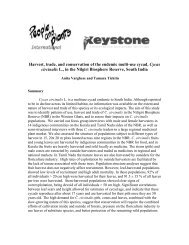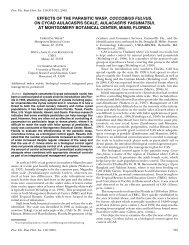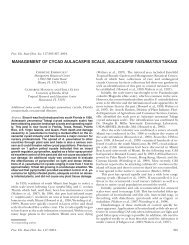Glossary of terms used in cycad systematics - Cycad Specialist Group
Glossary of terms used in cycad systematics - Cycad Specialist Group
Glossary of terms used in cycad systematics - Cycad Specialist Group
You also want an ePaper? Increase the reach of your titles
YUMPU automatically turns print PDFs into web optimized ePapers that Google loves.
Walters & Osborne – <strong>Cycad</strong> Classification: Concepts & Recommendations, Appendix 2 21<br />
status novus, stat. nov. New status or rank. E.g. Encephalartos manikensis (Gilliland) Gilliland was a<br />
status novus for the taxon previously named E.gratus Pra<strong>in</strong> var. manikensis Gilliland.<br />
stipule. Appendage at the base <strong>of</strong> a petiole. In Stangeria, a hood-like stipule subtends each leaf base.<br />
stoma, sometimes stomate, plural stomata. Orifice allow<strong>in</strong>g gaseous exchange across a plant<br />
epidermis, structurally def<strong>in</strong>ed by guard and subsidiary cells.<br />
striate. With longitud<strong>in</strong>al l<strong>in</strong>es, grooves or ridges.<br />
striolate. F<strong>in</strong>ely striate.<br />
strobilus, plural strobili. Reproductive structure <strong>of</strong> gymnosperms and some cryptogams such as<br />
Selag<strong>in</strong>ella; organised collection <strong>of</strong> sporophylls on a central axis. See also cone, megasporangiate<br />
strobilus, microsporangiate strobilus.<br />
subspecies, subsp. Taxonomic rank immediate below species; group <strong>of</strong> <strong>in</strong>dividuals which differ<br />
morphologically from another group but <strong>in</strong>sufficiently so to justify separate specific status, e.g. Cycas<br />
media subsp. banksii. Subspecies are reproductively compatible but are reproductively isolated from<br />
each other. The usefulness <strong>of</strong> <strong>in</strong>fraspecific taxonomic categories <strong>in</strong> <strong>cycad</strong>s is questioned <strong>in</strong> this<br />
volume. See also varietas.<br />
succubous. Arrangement <strong>in</strong> which a leaflet partially shields the leaflet below (the next proximal leaflet)<br />
when viewed from above (adaxially). Cf. <strong>in</strong>cubous.<br />
sucker. Vegetative axis orig<strong>in</strong>at<strong>in</strong>g from an adventitious bud and giv<strong>in</strong>g rise to an aerial branch or a<br />
‘clump<strong>in</strong>g’ effect if subterranean.<br />
sulcate. Hav<strong>in</strong>g a longitud<strong>in</strong>al groove or furrow. <strong>Cycad</strong> pollen gra<strong>in</strong>s are characteristically monosulcate.<br />
suture. L<strong>in</strong>e <strong>of</strong> open<strong>in</strong>g or dehiscence <strong>of</strong> a closed structure such as a <strong>cycad</strong> microsporangium.<br />
symbiont. Organism liv<strong>in</strong>g <strong>in</strong> a symbiotic relationship with another, e.g. the cyanobacteria <strong>in</strong> <strong>cycad</strong><br />
coralloid roots.<br />
sympatric. Of two or more taxa which exist naturally together <strong>in</strong> the same geographical area. Cf.<br />
allopatric.<br />
symplesiomorphy. Ancestral or underived character state shared by several members <strong>of</strong> a monophyletic<br />
group that does not def<strong>in</strong>e a monophyletic subset <strong>of</strong> that more <strong>in</strong>clusive group and has not<br />
experienced reversal. See also apomorphy, autapomorphy, pleisomorphy, synapomorphy.<br />
synapomorphy. Shared derived character state that unites two or more members <strong>of</strong> a monophyletic<br />
group. E.g. the presence <strong>of</strong> a glandular collar at the leaflet base is a synapomorphy for a<br />
monophyletic group compris<strong>in</strong>g Zamia macrochiera and Z. manicata. A synapomorphy at one level<br />
is an autoapomorphy at a more <strong>in</strong>clusive level. See also apomorphy, pleisomorphy,<br />
sympleisiomorphy.<br />
<strong>systematics</strong>. Description and classification <strong>of</strong> life forms and the study <strong>of</strong> their relationships.<br />
tabula. Lat<strong>in</strong> term <strong>used</strong> <strong>in</strong> some <strong>of</strong> the older French botanical literature to denote a black and white plate.<br />
See also planche.






